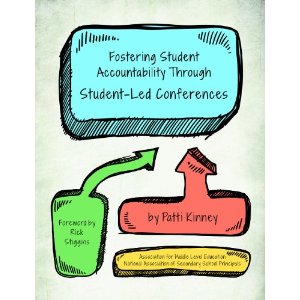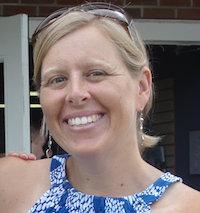Go Deep with SLCs
Fostering Student Accountability Through Student Led Conferences
by Patti Kinney
(AMLE/NASSP, 2012 – Learn more)
Let’s face it, 100+ parent-teacher conferences, especially if you are a middle grades core content teacher, can be exhausting, intimidating, overwhelming and can leave you feeling like you didn’t get a chance to really delve into what makes individual students tick.
It is nearly impossible to explain in 15 minutes how a child is learning. And there’s always someone missing in a traditional conference: the student. The book Fostering Student Accountability Through Student Led Conferences, by Patti Kinney, is obviously written by an educator with considerable teaching and leadership experience who understands a teacher’s responsibilities. The information presented in the text is helpful both to the first time teacher implementing an student-led parent conference (SLC) and a teacher who is fine tuning the process.

The text begins with an introduction by assessment expert, Rick Stiggins, who makes the important point that the book is not a “recipe for student led conferences, but rather a sharing of the ingredients that must be considered for them to be successful.” I appreciated this straightforward statement because each individual school community has specific needs, and Kinney has written and organized the text to allow for adaptations and modifications of the concepts she explains.
New to student-led conferences
Last year, I was introduced to the concept of Student Led Conferences (SLC’s) when I started teaching middle school Language Arts at the Community School of Davidson. I was intrigued. The idea of the students taking ownership of their learning, and gaining the skills to communicate that learning, matched my teaching philosophy and “felt good.” I found that the kids were able to communicate all the things they were proud of, and even had work samples to show their parents, but I wondered what I might do to help the students gain a better understanding of why SLCs are important and how they could make their presentations even more meaningful.
Our SLC’s didn’t address, deeply enough, the process and struggles that the students encountered as thinkers, writers and readers. Some parents also expressed a concern that they still didn’t know how their child was performing in relation to the “norm” for the grade level. I spent much of this past summer reflecting on how I could help my students reach the lofty goal of really examining their growth as learners and also offer enough evidence of student performance to satisfy parents. The other issue that I was struggling with was how to help students best communicate their growth. This requires my kids to take a risk and share work that reveals some deficits.
Fostering Student Accountability Through Student Led Conferences is helping me address many of these needs and concerns. In Chapter 4 (Self Assessment: Evaluation and Reflection), Kinney offers easy-to-use handouts and strategies that help guide the student to gather evidence, reflect in a meaningful way, and then mount a defense of the chosen work samples.
Finding time to support the SLC process
Collaboration is the most critical component of an SLC process that moves beyond simple “show and tell” to meaningful student growth and parent understanding. In the time-crunched world most of us live in, finding time for collaboration between teacher and student and between all the adults involved in SLC can be tricky. But Kinney reassures us that SLC doesn’t need to be an all or nothing process.
The book offers specific strategies to help with time management. Chapters 1 and 2 explain how to set the stage for SLC’s and even offers a year-long timeline that includes suggestions about how to schedule the gathering of work samples and communicate about the SLC process with students, other teachers, and parents. Subsequent chapters deal specifically with collaboration in the classroom and offer ideas to help students plan, gather information and organize their SLC.
Plenty of inspiration and practical help
Kinney has peppered her book with “We Are Making It Work” sidebars, sharing personal anecdotes about successful conferencing. These stories provide the reader with many different perspectives about how other teachers, teams and whole schools use SLC’s. These definitely provide inspiration for a teacher or faculty new to SLC’s.
The text consistently gives readers easy-to-understand-and-utilize handouts for students that address goals, missing work, work samples, and evaluations. They can be used as-is or adapted for a teacher’s or school’s specific needs. Kinney also includes models of how the handouts can be used. These would be very helpful to someone who was implementing an SLC for the first time.
As a teacher who was familiar with (but still green at) student-led conferences, I used Fostering Student Accountability Through Student Led Conferences mostly to help me rethink the components of our SLC process that most concerned me. From that perspective, the most helpful part of the text was the specific core feedback sheets. These templates provide a means to quickly summarize, for each content area, the student’s overall performance in that class. I appreciated that the sheet offered feedback both in academics and work habits. This quick and easy feedback template helped me solve the problem of parents leaving the SLC still puzzled about whether their child was meeting grade level expectations.
As I read this and other helpful material in the text, I wondered why I didn’t come up with some of these ideas on my own. The reality is, even when we sense the need for something to improve our teaching practice, we don’t always have the time to experiment and develop just the right solution. That’s why we read professional books and network with other teachers: if someone else has already thought it through and come up with a good idea, we don’t have to reinvent the wheel. We can just tweak it.
Change is never easy or smooth; this is one of the truths that teachers hold self evident. Patti Kinney’s helpful book gives teachers practical, realistic, and research based ideas for making the shift from the traditional parent-teacher conference into student led conferences without sugar coating the process. At the same time, it offers a great deal of encouragement and will leave most teachers feeling like they too can “Make it Work.”
Laura Collander is a middle school Language Arts teacher at Community School of Davidson in North Carolina. She has a Master’s Degree in Middle School Education. She has taught various grades, ranging from 5th grade up through college, but middle school is where her heart resides. She enjoys helping her students develop their voices as writers.

































Thank you for your kind words. I’m so glad you found the book useful and practical as that was the intent.